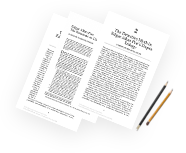Read this scenario and answer the following questions.
Tim and a friend had been drinking at a bar. When they left around 1:15 AM, they encountered two men Tim recognized as regular customers at the liquor store where he worked. He invited the men to come back to his house with his friend to smoke marijuana. Once there, one of the men held a gun to Tim’s head and demanded Tim give him his money, which he did; the two men immediately left.
A neighbor called police a few minutes later to report a burglary, describing the men as African American and one wearing a large hooded flannel shirt. Tim, meanwhile, left with his friend to search for the men and ended up stopping a police officer who happened to be responding to the burglary call. Another officer also responding to the call saw two men walking near Tim’s residence; he couldn’t tell their race, but one had a large hooded flannel shirt. When the officer turned his car to face the men, they ran between two house.
Using a canine unit, they located Tyrone, an African American male who was not wearing a flannel shirt. Tyrone told police he’d had an argument with his girlfriend and ran when he saw the patrol car because he feared she had called the police. Arrested and searched, no weapons or money were found on him. Tyrone was placed in a patrol car and driven to Tim’s residence to give Tim the opportunity to identify him as one of the suspects (this is what is called a “showup”). The overhead light in the car was left on. “Some guy was found running around nearby,” the officer who went to Tim’s home told Tim. “Will you come take a look at him?” Tim agreed and, when asked if Tyrone was one of the men, Tim said, “I’m 97% certain.” He indicated this was due to Tyrone’s size and hairstyle.
Both Tim and Tyrone were taken to the police station. Tim then observed Tyrone, seated alone in a room, through a two-way mirror. Again, Tim identified Tyrone as the man who robbed him. Not long after, Tim was shown Tyrone’s mug shot and Tim identified him for a third time.
Tyrone was convicted of armed robbery and appealed his conviction, claiming the first showup was unnecessarily suggestive because he sat alone in the patrol car, Tim was intoxicated, and the police had made certain comments to Tim about Tyrone.Show ups, in which only a single suspect is shown to a witness, have been ruled to be a lawful police practice, even if they are suggestive of guilt due to the isolation of the suspect. This is why Tyrone claims the actions were “unnecessarily” suggestive, going beyond the inevitable but acceptable suggestiveness the courts have acknowledged.
1. No matter what the courts have said, do YOU think showing a single suspect to someone is acceptable practice and, if so, under what conditions?
2. Do you agree with police showing a suspect to the witness while in a patrol car or while wearing handcuffs, as Tyrone was? Why or why not is this acceptable?
3. Do you think the comment made by police to Tim about Tyrone was appropriate? Why or why not?




